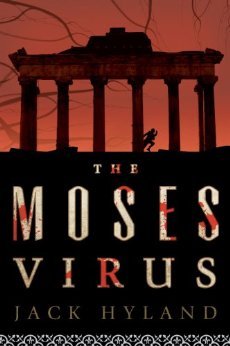Trouble in the Eternal City
From the terrace of his apartment on Via Gregoriana near the top of the Spanish Steps, Tom Stewart watched as the city started to come to life. Shops opening. Bread deliveries being made. People beginning their workday. He imagined that the rhythms of this eternal city remained unchanged for two thousand years.
The Moses Virus, the new book by TC Board Co-Chair Jack Hyland, begins in a dreamy, poetic vein, but in short order, what seems like a paean to the beauty of Rome turns dark. Two American archaeologists die mysteriously at an excavation in the Roman Forum; a deadly pathogen is implicated; and the mild-mannered Stewart, a forensic archaeologist who teaches at NYU, finds himself matching wits with sinister operatives from both the Vatican and a German biotech company.
Hyland, whose day job is in investment banking, has previously published a successful biography, Evangelism’s First Modern Media Star, The Life of Reverend Bill Stidger,about his grandfather. At a recent book talk at TC’s Gottesman Libraries, he revealed that his motivations for undertaking The Moses Virus, which was eight years in the making, were complex. (Read an interview with Hyland in examiner.com. To order The Moses Virus, visit www.jackwhyland.com.) Partly he welcomed “the pledge a thriller requires – to engage the reader almost continuously.” Partly he wrote from a sheer love of his chosen setting: as Chairman (and now Chairman Emeritus) of the American Academy, a sanctuary for visiting scholars, artists, writers and architects, Hyland has spent considerable time in the Eternal City. But perhaps most of all, he was intrigued by both the promise and perils of science.
“As a preacher in 1918, my grandfather had been in the presence of the worst virus mankind has ever experienced – the Spanish Influenza,” Hyland recounted in his talk at TC. “It went throughout the world because soldiers coming back from the Great War brought it with them wherever they went. It killed somewhere between 50-100 million people.”
The epidemic ended when the virus mutated into less deadly form. But during the past decade, working from the body of an Inuit woman that was preserved in the permafrost, the U.S. Centers for Disease Control and Prevention successfully reconstructed the virus for research purposes, and now it exists in 10 test tubes in one of their refrigerators.
“Was this a worthy project or a potentially devastating one?” Hyland asked.
It’s not giving away too much to add that The Moses Virus offers at least one possible answer.
Watch Jack Hyland's presentation of The Moses Virus at Teachers College:
Published Saturday, Feb. 8, 2014
